Performance-Based Characterization of Bituminous Mortars Prepared With Ladle Furnace Steel Slag
Abstract
:1. Introduction
2. Research Background and Problem Statement
3. Materials and Methods
3.1. Base Materials and Sample Preparation
3.2. Experimental Plan and Test Methods
4. Results and Discussion
4.1. Conventional Characteristics
4.2. LVE Properties
4.3. Rutting Potential
4.4. Fatigue Resistance
5. Conclusions
- the addition of LFS led to a clear stiffening effect on both the mastic and the mortars with a reduction of the LVE domain;
- the chemo-physical interaction of the LFS with the bitumen appeared to lead to appreciable differences in complex moduli and phase angles for both materials;
- the permanent deformation resistance and the related stress sensitivity have also been improved with the use of LFS aggregates, thanks to enhanced stiffness and elasticity;
- the LFS blends displayed a slightly reduced fatigue resistance with respect to the corresponding reference materials, especially in the case of mastics. A result that was in good agreement with the LVE properties measured through the frequency sweeps.
Author Contributions
Funding
Conflicts of Interest
References
- Bjørn, A.; Hauschild, M.Z. Cradle to Cradle and LCA. In Life Cycle Assessment: Theory and Practice; Hauschild, M.Z., Rosenbaum, R.K., Olsen, S.I., Eds.; Springer International Publishing: Cham, Switzerland, 2018; pp. 605–631. [Google Scholar] [CrossRef]
- World Steel Association. Available online: https://www.worldsteel.org/ (accessed on 1 October 2019).
- Dahlin, A.; Tilliander, A.; Eriksson, J.; Jönsson, P.G. Influence of ladle slag additions on BOF process performance. Ironmak. Steelmak. 2012, 39, 378–385. [Google Scholar] [CrossRef]
- Memoli, F.; Mapelli, C.; Guzzon, M. Recycling of ladle slag in the EAF: A way to improve environmental conditions and reduce variable costs in steel plants. Iron Steel Technol. 2007, 4, 68–76. [Google Scholar]
- Matino, I.; Colla, V.; Baragiola, S. Internal Slags Reuse in an Electric Steelmaking Route and Process Sustainability: Simulation of Different Scenarios Through the EIRES Monitoring Tool. Waste Biomass Valoris 2018, 1–11. [Google Scholar] [CrossRef]
- Euroslag European Association Representing Metallurgical Slag Producers and Processors. Available online: https://www.euroslag.com/ (accessed on 1 November 2019).
- Ortega-López, V.; Skaf, M.; Santamaría, A. The reuse of ladle furnace basic slags in clayey soil-stabilization applications. In Soil Stabilization: Types, Methods and Applications; Nova Science Publishers, Inc.: Hauppauge, New York, NY, USA, 2017; pp. 231–271. [Google Scholar]
- Shi, C. Characteristics and cementitious properties of ladle slag fines from steel production. Cem. Concr. Res. 2002, 32, 459–462. [Google Scholar] [CrossRef]
- Wang, Y.; Suraneni, P. Experimental methods to determine the feasibility of steel slags as supplementary cementitious materials. Constr. Build. Mater. 2019, 204, 458–467. [Google Scholar] [CrossRef]
- Jiang, Y.; Ling, T.-C.; Shi, C.; Pan, S.-Y. Characteristics of steel slags and their use in cement and concrete—A review. Resour. Conserv. Recycl. 2018, 136, 187–197. [Google Scholar] [CrossRef]
- Nguyen, H.; Adesanya, E.; Ohenoja, K.; Kriskova, L.; Pontikes, Y.; Kinnunen, P.; Illikainen, M. Byproduct-based ettringite binder—A synergy between ladle slag and gypsum. Constr. Build. Mater. 2019, 197, 143–151. [Google Scholar] [CrossRef]
- Sáez-De-Guinoa, A.; Ferreira, V.J.; López-Sabirón, A.M.; Aranda-Usón, A.; Lausín-González, C.; Berganza-Conde, C.; Ferreira, G. Utilization of Ladle Furnace slag from a steelwork for laboratory scale production of Portland cement. Constr. Build. Mater. 2015, 94, 837–843. [Google Scholar] [CrossRef]
- Parron-Rubio, M.E.; Perez-Garcia, F.; Gonzalez-Herrera, A.; Oliveira, M.J.; Rubio-Cintas, M.D. Slag substitution as a cementing material in concrete: Mechanical, physical and environmental properties. Materials 2019, 12, 2845. [Google Scholar] [CrossRef] [Green Version]
- Sideris, K.K.; Tassos, C.; Chatzopoulos, A.; Manita, P. Mechanical characteristics and durability of self compacting concretes produced with ladle furnace slag. Constr. Build. Mater. 2018, 170, 660–667. [Google Scholar] [CrossRef]
- Santamaría, A.; Rojí, E.; Skaf, M.; Marcos, I.; González, J.J. The use of steelmaking slags and fly ash in structural mortars. Constr. Build. Mater. 2016, 106, 364–373. [Google Scholar] [CrossRef]
- Xu, B.; Yi, Y. Soft clay stabilization using ladle slag-ground granulated blastfurnace slag blend. Appl. Clay Sci. 2019, 178, 105136. [Google Scholar] [CrossRef]
- Ortega-López, V.; Manso, J.M.; Cuesta, I.I.; González, J.J. The long-term accelerated expansion of various ladle-furnace basic slags and their soil-stabilization applications. Constr. Build. Mater. 2014, 68, 455–464. [Google Scholar] [CrossRef]
- Milačič, R.; Zuliani, T.; Oblak, T.; Mladenovič, A.; Ščančar, J. Environmental impacts of asphalt mixes with electric arc furnace steel slag. J. Environ. Qual. 2011, 40, 1153–1161. [Google Scholar] [CrossRef]
- Skaf, M.; Ortega-López, V.; Fuente-Alonso, J.A.; Santamaría, A.; Manso, J.M. Ladle furnace slag in asphalt mixes. Constr. Build. Mater. 2016, 122, 488–495. [Google Scholar] [CrossRef] [Green Version]
- Bocci, E. Use of ladle furnace slag as filler in hot asphalt mixtures. Constr. Build. Mater. 2018, 161, 156–164. [Google Scholar] [CrossRef]
- Skaf, M.; Pasquini, E.; Revilla-Cuesta, V.; Ortega-Lopez, V. Performance and Durability of Porous Asphalt Mixtures Manufactured Exclusively with Electric Steel Slags. Materials Basel 2019, 12, 3306. [Google Scholar] [CrossRef] [Green Version]
- Skaf, M.; Manso, J.M.; Aragón, Á.; Fuente-Alonso, J.A.; Ortega-López, V. EAF slag in asphalt mixes: A brief review of its possible re-use. Resour. Conserv. Recycl. 2017, 120, 176–185. [Google Scholar] [CrossRef]
- Pasetto, M.; Baliello, A.; Giacomello, G.; Pasquini, E. Sustainable solutions for road pavements: A multi-scale characterization of warm mix asphalts containing steel slags. J. Clean. Prod. 2017, 166, 835–843. [Google Scholar] [CrossRef]
- Skaf, M.; Ortega-López, V.; Manso, J.; Pasquini, E.; Pasetto, M. Mix design and preliminary validation of sustainable asphalt concrete manufactured with electric arc and ladle furnace steel slags. In Road and Rail Infrastructure V, Proceedings of the Conference CETRA 2018; Department of Transportation, Faculty of Civil Engineering, University of Zagreb: Zagreb, Croatia, 2018; pp. 511–517. [Google Scholar] [CrossRef]
- Underwood, B.S.; Kim, Y.R. Experimental investigation into the multiscale behaviour of asphalt concrete. Int. J. Pavement Eng. 2011, 12, 357–370. [Google Scholar] [CrossRef]
- Nabizadeh, H.; Haghshenas, H.F.; Kim, Y.R.; Aragão, F.T.S. Effects of rejuvenators on high-RAP mixtures based on laboratory tests of asphalt concrete (AC) mixtures and fine aggregate matrix (FAM) mixtures. Constr. Build. Mater. 2017, 152, 65–73. [Google Scholar] [CrossRef]
- Gong, X.; Romero, P.; Dong, Z.; Li, Y. Investigation on the low temperature property of asphalt fine aggregate matrix and asphalt mixture including the environmental factors. Constr. Build. Mater. 2017, 156, 56–62. [Google Scholar] [CrossRef]
- Arega, Z.A.; Bhasin, A.; De Kesel, T. Influence of extended aging on the properties of asphalt composites produced using hot and warm mix methods. Constr. Build. Mater. 2013, 44, 168–174. [Google Scholar] [CrossRef]
- Riccardi, C.; Cannone Falchetto, A.; Losa, M.; Wistuba, M. Back-calculation method for determining the maximum RAP content in Stone Matrix Asphalt mixtures with good fatigue performance based on asphalt mortar tests. Constr. Build. Mater. 2016, 118, 364–372. [Google Scholar] [CrossRef]
- Riccardi, C.; Cannone Falchetto, A.; Losa, M.; Wistuba, M.P. Rheological modeling of asphalt binder and asphalt mortar containing recycled asphalt material. Mater. Struct. Mater. Constr. 2016, 49, 4167–4183. [Google Scholar] [CrossRef]
- Williams, M.L.; Landel, R.F.; Ferry, J.D. The Temperature Dependence of Relaxation Mechanisms in Amorphous Polymers and Other Glass-forming Liquids. J. Am. Chem. Soc. 1955, 77, 3701–3707. [Google Scholar] [CrossRef]
- Bahia, H.U.; Hanson, D.; Zeng, M.; Zhai, H.; Khatri, M.; Anderson, R. Characterization of Modified Asphalt Binders in Superpave Mix Design; Transportation Research Board: Washington, DC, USA, 2001. [Google Scholar]
- Zhu, J.; Alavi, M.Z.; Harvey, J.; Sun, L.; He, Y. Evaluating fatigue performance of fine aggregate matrix of asphalt mix containing recycled asphalt shingles. Constr. Build. Mater. 2017, 139, 203–211. [Google Scholar] [CrossRef]
- Kim, Y.; Lee, H.J.; Little, D.N.; Kim, Y.R.; Gibson, N.; King, G.; Pellinen, T.; Fee, F. A Simple Testing Method to Evaluate Fatigue Fracture and Damage Performance of Asphalt Mixtures; Association of Asphalt Paving Technologists: Lino Lakes, MN, USA, 2006; pp. 755–788. [Google Scholar]
- Pasetto, M.; Baliello, A.; Giacomello, G.; Pasquini, E. Aesthetic and Mechanical Suitability of a Clear Synthetic Resin as a Unconventional Binder for Road Pavements. Adv. Mater. Sci. Eng. 2019, 2019. [Google Scholar] [CrossRef] [Green Version]
- Pasetto, M.; Baliello, A.; Giacomello, G.; Pasquini, E. Rheological characterization of warm-modified asphalt mastics containing electric arc furnace steel slags. Adv. Mater. Sci. Eng. 2016, 2016. [Google Scholar] [CrossRef] [Green Version]
- Bazzaz, M.; Darabi, M.K.; Little, D.N.; Garg, N. Effect of evotherm-M1 on properties of asphaltic materials used at NAPMRC testing facility. J. Test. Eval. 2019, 48. [Google Scholar] [CrossRef]
- Bocci, E.; Mazzoni, G.; Canestrari, F. Ageing of rejuvenated bitumen in hot recycled bituminous mixtures: influence of bitumen origin and additive type. Road Mater. Pavement Des. 2019, 20 (Suppl. S1), S127–S148. [Google Scholar] [CrossRef]
- Cardone, F.; Frigio, F.; Ferrotti, G.; Canestrari, F. Influence of mineral fillers on the rheological response of polymer-modified bitumens and mastics. J. Traffic Transp. Eng. 2015, 2, 373–381. [Google Scholar] [CrossRef] [Green Version]

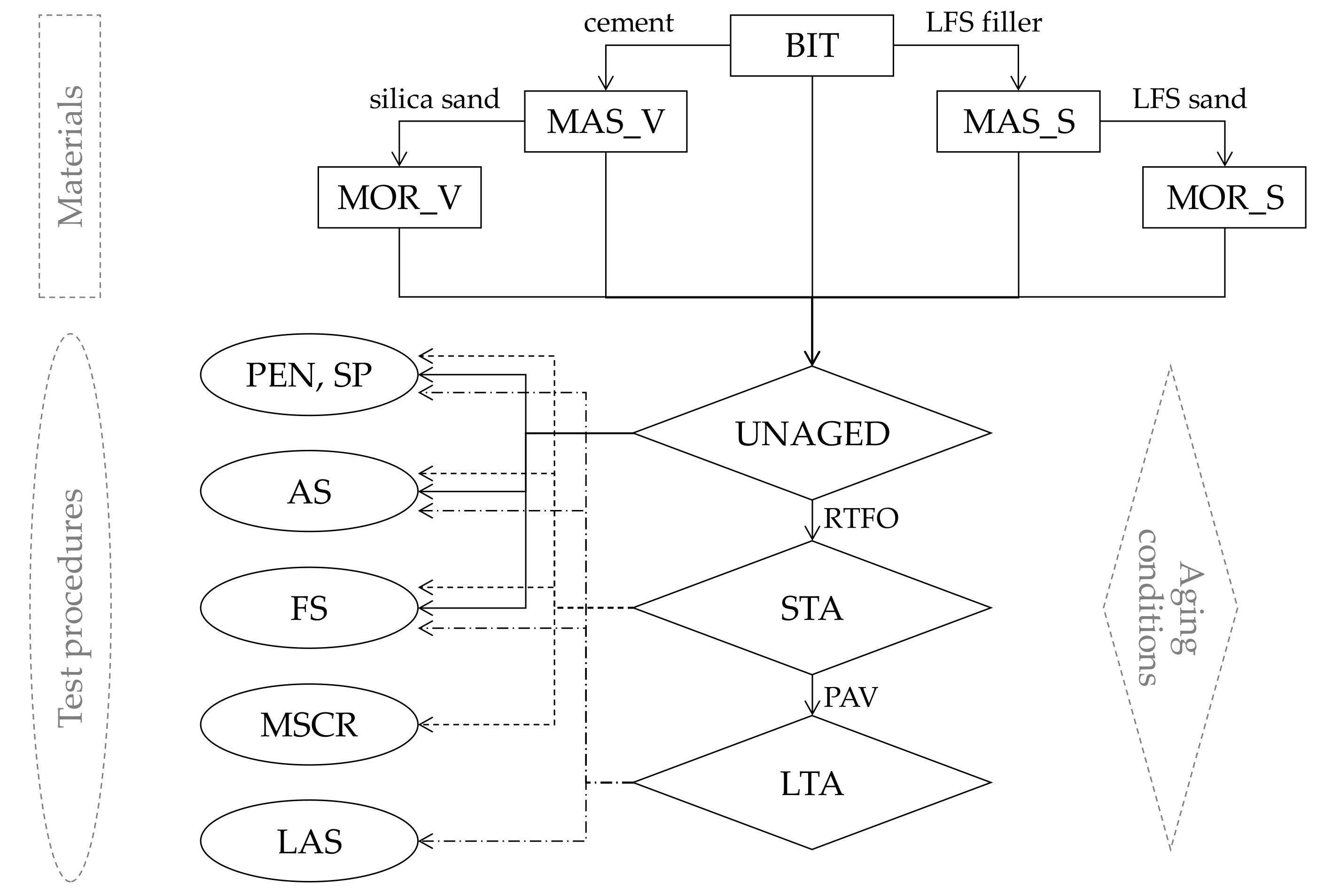
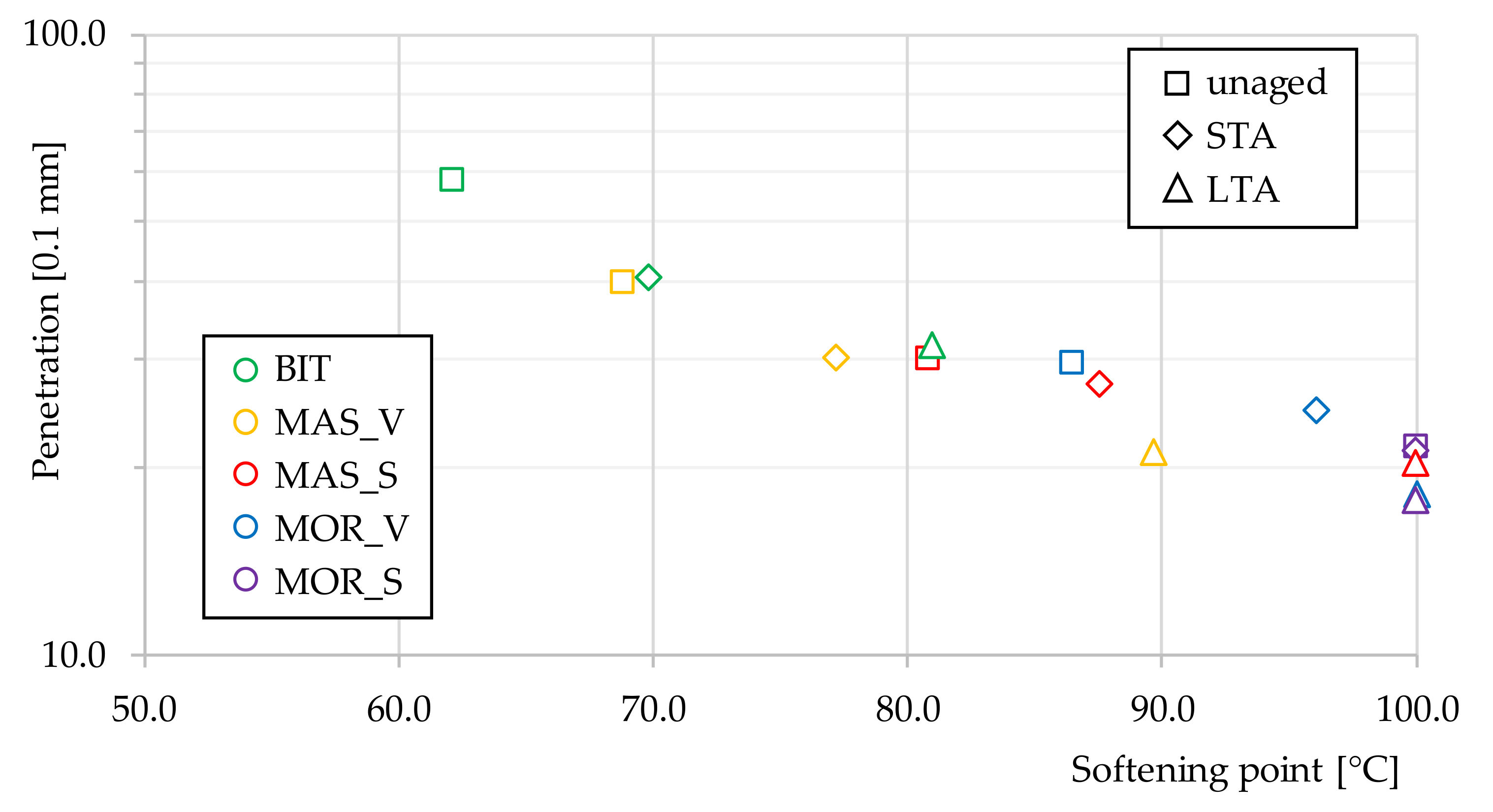
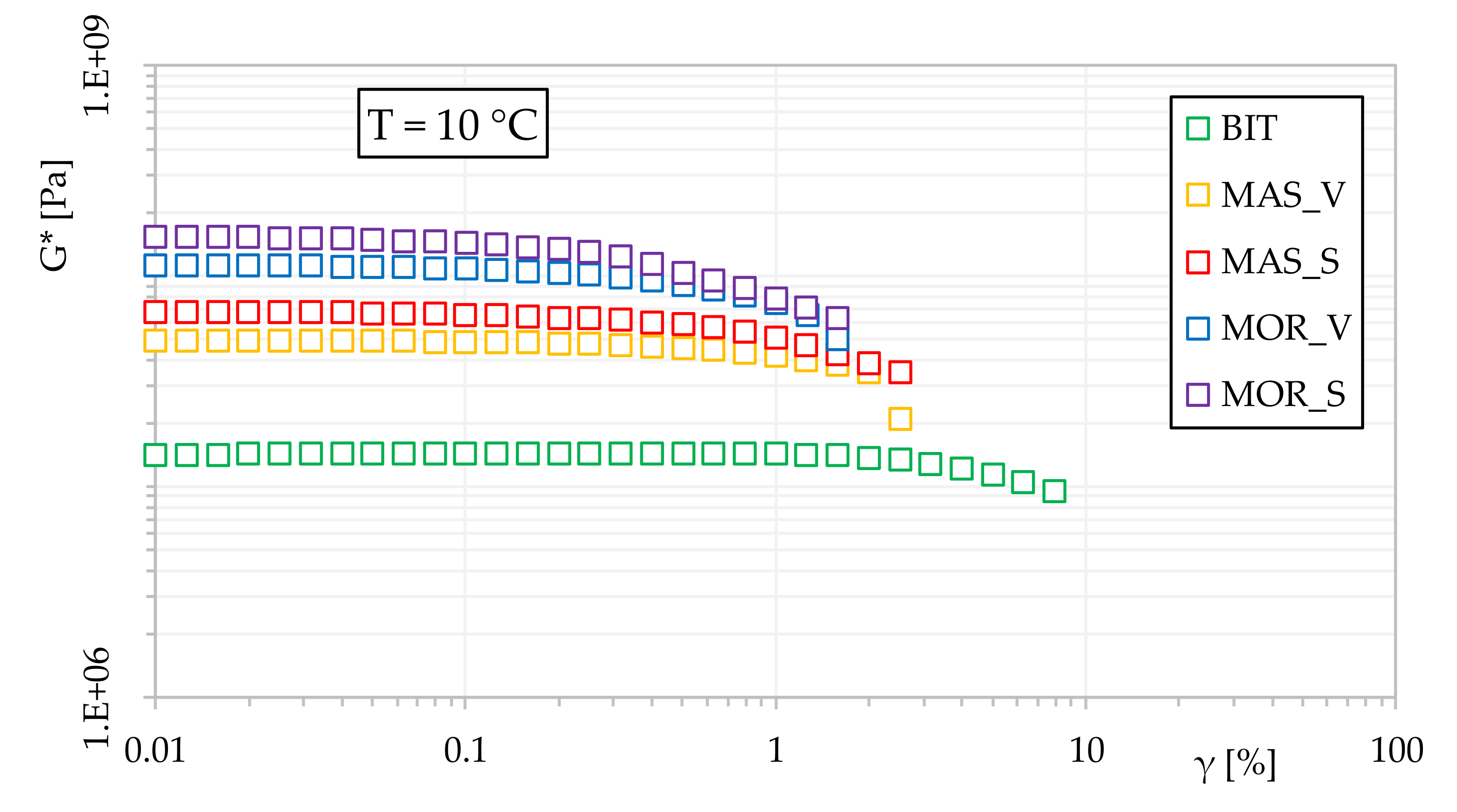
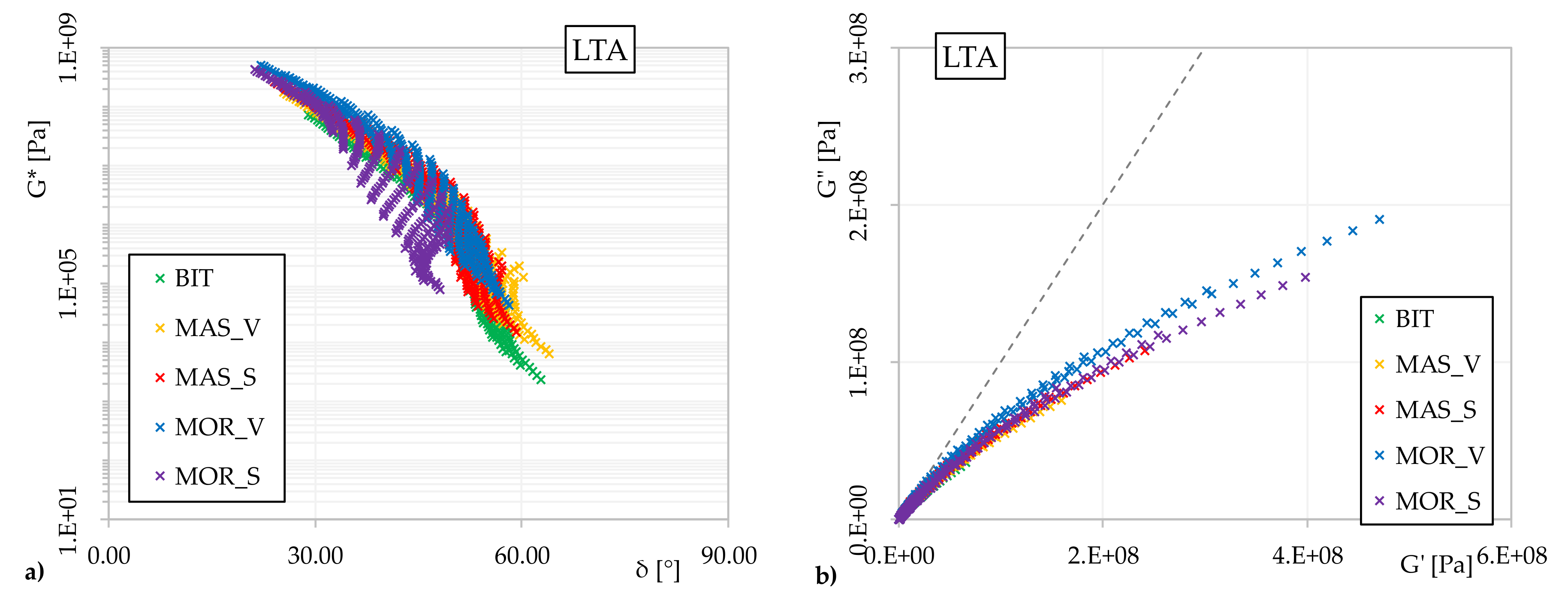
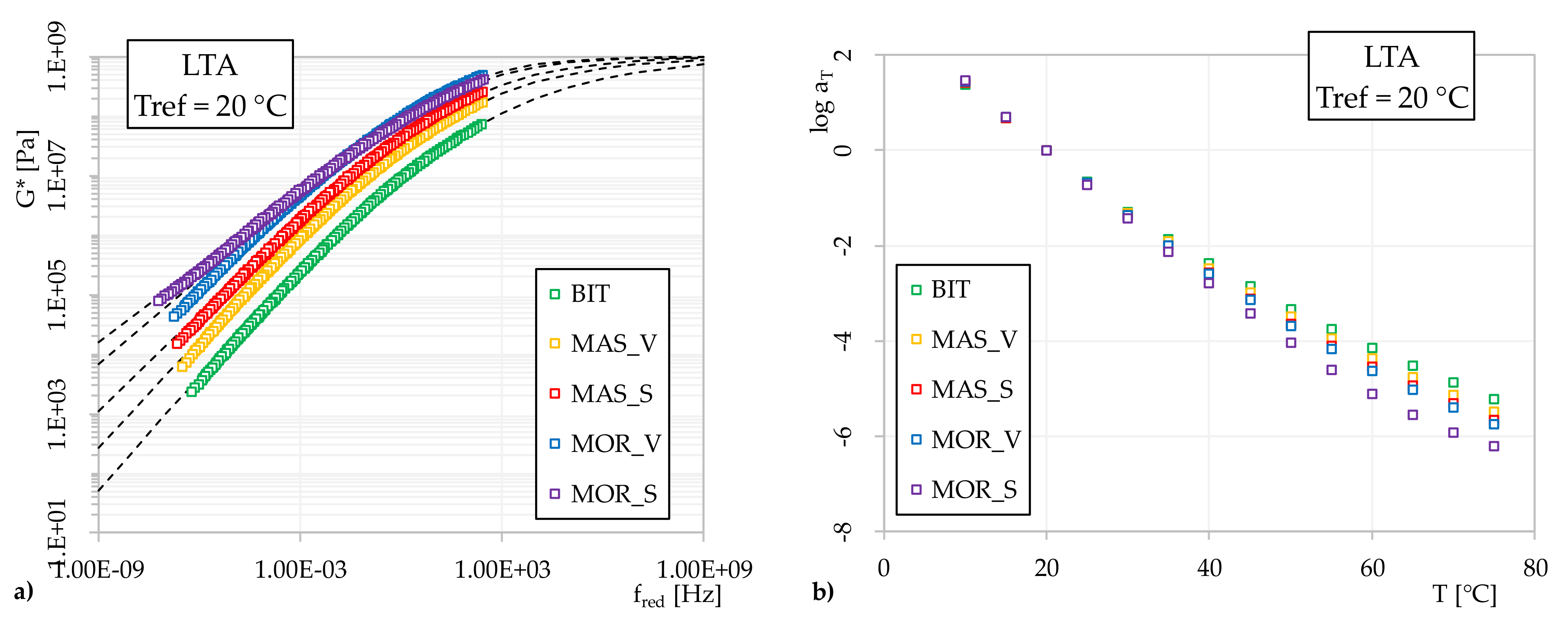


| Characteristic | Test Method | Value |
|---|---|---|
| Penetration at 25 °C | EN 1426 | 58.2 × 0.1 mm |
| Softening point | EN 1427 | 62.1 °C |
| Ductility at 5 °C | ASTM D113 | 170 mm |
| Dynamic viscosity at 100 °C | EN 13702 | 17.5 Pa×s |
| Dynamic viscosity at 150 °C | EN 13702 | 0.8 Pa×s |
| Residue after short-term aging (EN 12607-1) | ||
| Retained penetration at 25 °C | EN 1426 | 69.9% |
| Increase in softening point | EN 1427 | 7.7 °C |
| Characteristic | Test Method | Silica | Ladle Furnace Slag (LFS) |
|---|---|---|---|
| Bulk density | EN 1097-6 | 2.74 g/cm3 | 2.83 g/cm3 |
| Fineness modulus | EN 933-1 | 2.9 | 4.2 |
| Blaine specific surface | EN 196-6 | - | 2654–3091 cm2/g |
| Sand equivalent | EN 933-8 | 78% | 50% |
| Plasticity Index | CEN ISO/TS 17892-12 | Non-plastic | Non-plastic |
| CaO | SiO2 | MgO | Al2O3 | Fe2O3 | MnO | |
|---|---|---|---|---|---|---|
| LFS [% by weight] | 56.7 | 17.7 | 9.6 | 6.6 | 2.2 | 0.3 |
| Material ID | Bitumen | Filler | Fine Sand |
|---|---|---|---|
| Bitumen (BIT) | PMB 45/80-60 | - | - |
| MAStic with Virgin aggregate (MAS_V) | PMB 45/80-60 | Cement | - |
| MAStic with LFS aggregate (MAS_S) | PMB 45/80-60 | LFS | - |
| MORtar with Virgin aggregates (MOR_V) | PMB 45/80-60 | Cement | Silica |
| MORtar with LFS aggregates (MOR_S) | PMB 45/80-60 | LFS | LFS |
| Material | Aging | Initial G* [Pa] | γlimit [%] |
|---|---|---|---|
| BIT | Unaged | 1.11 107 | 2.00 |
| Short-term aged (STA) | 1.45 107 | 2.00 | |
| Long-term aged (LTA) | 3.20 107 | 1.80 | |
| MAS_V | Unaged | 4.93 107 | 0.40 |
| Short-term aged (STA) | 6.32 107 | 0.36 | |
| Long-term aged (LTA) | 9.04 107 | 0.28 | |
| MAS_S | Unaged | 6.36 107 | 0.17 |
| Short-term aged (STA) | 6.78 107 | 0.16 | |
| Long-term aged (LTA) | 1.54 108 | 0.14 | |
| MOR_V | Unaged | 9.17 107 | 0.16 |
| Short-term aged (STA) | 1.12 108 | 0.15 | |
| Long-term aged (LTA) | 1.56 108 | 0.07 | |
| MOR_S | Unaged | 1.05E 108 | 0.09 |
| Short-term aged (STA) | 1.21E 108 | 0.08 | |
| Long-term aged (LTA) | 2.02E 108 | 0.05 |
| Material | Aging | C1 | C2 | fc [Hz] | k | me | R |
|---|---|---|---|---|---|---|---|
| BIT | Unaged | 13.7 | 104.1 | 263.1 | 0.19 | 0.85 | 1.35 |
| STA | 15.2 | 114.3 | 145.4 | 0.16 | 0.81 | 1.53 | |
| LTA | 17.5 | 129.0 | 120.3 | 0.16 | 0.66 | 1.23 | |
| MAS_V | Unaged | 13.5 | 105.7 | 131.5 | 0.22 | 0.77 | 1.09 |
| STA | 14.7 | 115.2 | 106.3 | 0.21 | 0.71 | 1.02 | |
| LTA | 19.5 | 139.8 | 71.1 | 0.19 | 0.61 | 0.97 | |
| MAS_S | Unaged | 13.8 | 107.0 | 109.5 | 0.25 | 0.76 | 0.92 |
| STA | 14.6 | 113.1 | 95.7 | 0.24 | 0.70 | 0.89 | |
| LTA | 20.4 | 141.1 | 69.5 | 0.22 | 0.55 | 0.74 | |
| MOR_V | Unaged | 14.7 | 106.4 | 157.9 | 0.29 | 0.65 | 0.67 |
| STA | 19.4 | 138.1 | 129.2 | 0.30 | 0.51 | 0.52 | |
| LTA | 21.4 | 147.8 | 79.5 | 0.30 | 0.48 | 0.48 | |
| MOR_S | Unaged | 15.1 | 109.1 | 130.1 | 0.31 | 0.60 | 0.58 |
| STA | 16.5 | 125.3 | 94.6 | 0.29 | 0.48 | 0.50 | |
| LTA | 25.4 | 163.2 | 75.3 | 0.29 | 0.43 | 0.45 |
| Material | Temperature [°C] | τ = 0.1 kPa | τ = 3.2 kPa | τ = 10 kPa | |||||
|---|---|---|---|---|---|---|---|---|---|
| R [%] | Jnr [1/kPa] | R [%] | Jnr [1/kPa] | Jnr-diff 1 [%] | R [%] | Jnr [1/kPa] | Jnr-diff 2 [%] | ||
| BIT | 50 | 72 | 0.03 | 71.7 | 0.03 | 1.2 | - | - | - |
| 60 | 62.4 | 0.13 | 58.8 | 0.15 | 11.9 | - | - | - | |
| 70 | 46.2 | 0.6 | 31 | 0.84 | 40.5 | - | - | - | |
| 80 | 26.1 | 2.49 | 6.1 | 4.02 | 61.5 | - | - | - | |
| MAS_V | 50 | - | - | - | - | - | - | - | - |
| 60 | 64.3 | 0.02 | 59.3 | 0.03 | 13.3 | 52.8 | 0.03 | 18.2 | |
| 70 | 48.7 | 0.1 | 36.5 | 0.13 | 23.2 | 24.6 | 0.17 | 27.4 | |
| 80 | 28.9 | 0.43 | 12.8 | 0.59 | 36.9 | 5.9 | 0.75 | 31.1 | |
| MAS_S | 50 | - | - | - | - | - | - | - | - |
| 60 | 65.5 | 0.01 | 59.1 | 0.01 | 4.4 | 53 | 0.01 | 6.3 | |
| 70 | 50.5 | 0.04 | 37.3 | 0.05 | 16.2 | 26.9 | 0.05 | 11 | |
| 80 | 32.4 | 0.14 | 17 | 0.18 | 20.9 | 8.6 | 0.2 | 36.4 | |
| MOR_V | 50 | - | - | - | - | - | - | - | - |
| 60 | - | - | - | - | - | - | - | - | |
| 70 | 69.3 | <0.01 | 45.5 | 0.02 | 22.7 | 32.8 | 0.02 | 6.7 | |
| 80 | 66 | 0.01 | 27.4 | 0.02 | 35.6 | 16.5 | 0.03 | 10.8 | |
| MOR_S | 50 | - | - | - | - | - | - | - | - |
| 60 | - | - | - | - | - | - | - | - | |
| 70 | 63.5 | <0.01 | 44.7 | 0.01 | 5.6 | 39.7 | 0.01 | 2.8 | |
| 80 | 60.9 | 0.01 | 38 | 0.01 | 7.9 | 30.9 | 0.02 | 7.7 | |
| Material | A | B | γ 6[%] | G* (20 °C; 10 Hz) 1 [Pa] | δ (20 °C; 10 Hz) 1 [deg] |
|---|---|---|---|---|---|
| BIT | 22,687 | 4.179 | 0.40 | 2.42 107 | 36.67 |
| MAS_V | 54.2 | 4.496 | 0.11 | 6.37 107 | 33.28 |
| MAS_S | 2.75 | 5.004 | 0.08 | 1.01 108 | 32.01 |
| MOR_V | 0.45 | 4.923 | 0.05 | 2.09 108 | 29.75 |
| MOR_S | 0.28 | 4.946 | 0.05 | 1.75 108 | 28.48 |
© 2020 by the authors. Licensee MDPI, Basel, Switzerland. This article is an open access article distributed under the terms and conditions of the Creative Commons Attribution (CC BY) license (http://creativecommons.org/licenses/by/4.0/).
Share and Cite
Pasetto, M.; Baliello, A.; Pasquini, E.; Skaf, M.; Ortega-López, V. Performance-Based Characterization of Bituminous Mortars Prepared With Ladle Furnace Steel Slag. Sustainability 2020, 12, 1777. https://doi.org/10.3390/su12051777
Pasetto M, Baliello A, Pasquini E, Skaf M, Ortega-López V. Performance-Based Characterization of Bituminous Mortars Prepared With Ladle Furnace Steel Slag. Sustainability. 2020; 12(5):1777. https://doi.org/10.3390/su12051777
Chicago/Turabian StylePasetto, Marco, Andrea Baliello, Emiliano Pasquini, Marta Skaf, and Vanesa Ortega-López. 2020. "Performance-Based Characterization of Bituminous Mortars Prepared With Ladle Furnace Steel Slag" Sustainability 12, no. 5: 1777. https://doi.org/10.3390/su12051777





